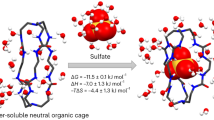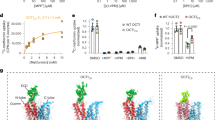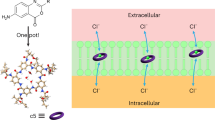Abstract
Attractive in theory and confirmed to exist, anion–π interactions have never really been seen at work. To catch them in action, we prepared a collection of monomeric, cyclic and rod-shaped naphthalenediimide transporters. Their ability to exert anion–π interactions was demonstrated by electrospray tandem mass spectrometry in combination with theoretical calculations. To relate this structural evidence to transport activity in bilayer membranes, affinity and selectivity sequences were recorded. π-acidification and active-site decrowding increased binding, transport and chloride > bromide > iodide selectivity, and supramolecular organization inverted acetate > nitrate to nitrate > acetate selectivity. We conclude that anion–π interactions on monomeric surfaces are ideal for chloride recognition, whereas their supramolecular enhancement by π,π-interactions appears perfect to target nitrate. Chloride transporters are relevant to treat channelopathies, and nitrate sensors to monitor cellular signaling and cardiovascular diseases. A big impact on organocatalysis can be expected from the stabilization of anionic transition states on chiral π-acidic surfaces.
This is a preview of subscription content, access via your institution
Access options
Subscribe to this journal
Receive 12 print issues and online access
$259.00 per year
only $21.58 per issue
Buy this article
- Purchase on Springer Link
- Instant access to full article PDF
Prices may be subject to local taxes which are calculated during checkout





Similar content being viewed by others
References
Schottel, B. L., Chifotides, H. T. & Dunbar, K. R. Anion-π interactions. Chem. Soc. Rev. 37, 68–83 (2008).
Gamez, P., Mooibroek, T. J., Teat, J. S. & Reedijk, J. Anion binding involving π-acidic heteroaromatic rings. Acc. Chem. Res. 40, 435–444 (2007).
Quinonero, D. et al. Anion-π interactions: Do they exist? Angew. Chem. Int. Ed. 41, 3389–3392 (2002).
Mascal, M., Armstrong, A. & Bartberger, M. D. Anion-aromatic bonding: A case for anion recognition by π-acidic rings. J. Am. Chem. Soc. 124, 6274–6276 (2002).
Alkorta, I., Rozas, I. & Elguero, J. Interaction of anions with perfluoro aromatic compounds. J. Am. Chem. Soc. 124, 8593–8598 (2002).
Rosokha, Y. S., Lindeman, S. V., Rosokha, S. V. & Kochi, J. K. Halide recognition through diagnostic anion-π interactions: Molecular complexes of Cl−, Br−, and I− with olefinic and aromatic receptors. Angew. Chem. Int. Ed. 43, 4650–4652 (2004).
Gil-Ramírez, G., Escudero-Adán, E. C., Benet-Buchholz, J. & Ballester, P. Quantitative evaluation of anion-π interactions in solution. Angew. Chem. Int. Ed. 47, 4114–4118 (2008).
Zaccheddu, M., Filippi, C. & Buda, F. Anion-π and π-π cooperative interactions regulating the self-assembly of nitrate-triazine-triazine complexes. J. Phys. Chem. A 112, 1627–1632 (2008).
Berryman, O. B., Bryantsev, V. S., Stay, D. P., Johnson, D. W. & Hay, B. P. Structural criteria for the design of anion receptors: The interaction of halides with electron-deficient arenes. J. Am. Chem. Soc. 129, 48–58 (2007).
Hay, B. P. & Bryantsev, V. S. Anion-arene adducts: C-H hydrogen bonding, anion-π interaction, and carbon bonding motifs. Chem. Commun. 2417–2428 (2008).
Hay, B. P. & Custelcean, R. Anion-π interactions in crystal structures: Commonplace or extraordinary? Cryst. Growth Design 9, 2539–2545 (2009).
Ma, J. C. & Dougherty, D. A. The cation-π interaction. Chem. Rev. 97, 1303–1324 (1997).
Mareda, J. & Matile, S. Anion-π slides for transmembrane transport. Chem. Eur. J. 15, 28–37 (2009).
Gorteau, V., Bollot, G., Mareda, J. & Matile, S. Rigid-rod anion-π slides for multiion hopping across lipid bilayers. Org. Biomol. Chem. 5, 3000–3012 (2007).
Davis, A. P., Sheppard, D. N. & Smith, B. D. Development of synthetic membrane transporters for anions. Chem. Soc. Rev. 36, 348–357 (2007).
Gokel, G. W. & Barkey, N. Transport of chloride ion through phospholipid bilayers mediated by synthetic ionophores. New J. Chem. 33, 947–963 (2009).
Li, X., Shen, B., Yao, X. Q. & Yang, D. Synthetic chloride channel regulates cell membrane potentials and voltage-gated calcium channels. J. Am. Chem. Soc. 131, 13676–13680 (2009).
Deng, G., Dewa, T. & Regen, S. L. A synthetic ionophore that recognizes negatively charged phospholipid membranes. J. Am. Chem. Soc. 118, 8975–8976 (1996).
Davis, J. T. et al. Using “small” molecules to facilitate exchange of bicarbonate and chloride anions across liposomal membranes. Nature Chem. 1, 138–144 (2009).
Hennig, A., Fischer, L., Guichard, G. & Matile, S. Anion-macrodipole interactions: self-assembling, macrocyclic oligourea/amide anion transporters that respond to membrane polarization. J. Am. Chem. Soc. 131, 16889–16895 (2009).
Bhosale, S. V., Jani, C. H. & Langford, S. J. Chemistry of naphthalene diimides. Chem. Soc. Rev. 37, 331–342 (2008).
Jones, R. A., Facchetti, A., Wasielewski, M. R. & Marks, T. J. Tuning orbital energetics in arylene diimide semiconductors. Materials design for ambient stability of n-type charge transport. J. Am. Chem. Soc. 129, 15259–15278 (2007).
Bhosale, S. et al. Photoproduction of proton gradients with π-stacked fluorophore scaffolds in lipid bilayers. Science 313, 84–86 (2006).
Gabutti, S. et al. A rigid sublimable naphthalenediimide cyclophane as model compound for UHV STM experiments. Chem. Commun. 2370–2372 (2008).
Könemann, M. Naphthalenetetracarboxylic acid derivatives and their use as semiconductors. WO/2007/074137.
Matile, S. & Sakai, N. in Analytical Methods in Supramolecular Chemistry (ed. Schalley, C. A.) 391–418 (Wiley, 2007).
Kogej, M. & Schalley, C. A. in Analytical Methods in Supramolecular Chemistry (ed. Schalley, C. A.) 104–162 (Wiley, 2007).
Cooks, R. G., Patrick, J. S., Kotiaho, T. & McLuckey, S. A. Thermochemical determinations by the kinetic method. Mass Spectrom. Rev. 13, 287–339 (1994).
Perdew, J. P., Burke, K. & Ernzerhof, M. Generalized gradient approximation made simple. Phys. Rev. Lett. 77, 3865–3868 (1996).
Ernzerhof, M. & Scuseria, G. E. Assessment of the Perdew-Burke-Ernzenhof exchange-correlation functional. J. Chem. Phys. 110, 5029–5036 (1999).
Frisch, M. J. et al. Gaussian 03, Revision C.02 (Gaussian, 2004).
McNally, B. A., Koulov, A. V., Smith, B. D., Joos, J-B. & Davis, A. P. A fluorescent assay for chloride transport; identification of a synthetic anionophore with improved activity. Chem. Commun. 1087–1089 (2005).
Butler, A. R. & Feelisch, M. Therapeutic uses of inorganic nitrite and nitrate - from the past to the future. Circulation 117, 2151–2159 (2008).
Kishore, R. S. K. et al. Ordered and oriented supramolecular n/p-heterojunction surface architectures: Completion of the primary color collection. J. Am. Chem. Soc. 131, 11106–11116 (2009).
Acknowledgements
We thank D.-H. Tran, J. Praz and L. Maffiolo for contributions to synthesis, D. Jeannerat, A. Pinto and S. Grass for NMR measurements, P. Perrottet, N. Oudry and G. Hopfgartner for mass spectrometry, the Swiss National Supercomputing Center in Manno for CPU time, and the University of Geneva (S.M., J.M.), the University of Basel (M.M.), the Deutsche Forschungsgemeinschaft (C.A.S.), the Fonds der Chemischen Industrie (C.A.S.), the NCCR Nanoscale Sciences of the SNF (S.G., M.M.) and the Swiss NSF (S.M., M.M.) for financial support.
Author information
Authors and Affiliations
Contributions
R.E.D., V.R., J.M., T.T., S.G. and A.H. synthesized compounds, A.H. and R.E.D. transported ions across membranes, D.P.W. performed the (tandem) mass spectrometric experiments and evaluated the mass spectrometry data, D.E. prepared computational models, M.M., J.M., C.A.S. and S.M. directed the study, contributing to design, execution and interpretation of experiments, computer modelling and manuscript writing.
Corresponding author
Ethics declarations
Competing interests
The authors declare no competing financial interests.
Supplementary information
Supplementary information
Supplementary information (PDF 2050 kb)
Rights and permissions
About this article
Cite this article
Dawson, R., Hennig, A., Weimann, D. et al. Experimental evidence for the functional relevance of anion–π interactions. Nature Chem 2, 533–538 (2010). https://doi.org/10.1038/nchem.657
Received:
Accepted:
Published:
Issue Date:
DOI: https://doi.org/10.1038/nchem.657
This article is cited by
-
Diazapyrenes: interaction with nucleic acids and biological activity
Chemistry of Heterocyclic Compounds (2020)
-
Selective uptake and sensing of nitrate in poly(3,4-ethylenedioxythiophene)
Scientific Reports (2017)
-
Exploiting non-covalent π interactions for catalyst design
Nature (2017)
-
Photomodulation of fluoride ion binding through anion-π interactions using a photoswitchable azobenzene system
Scientific Reports (2016)
-
Heteroaromatic organic compound with conjugated multi-carbonyl as cathode material for rechargeable lithium batteries
Scientific Reports (2016)



